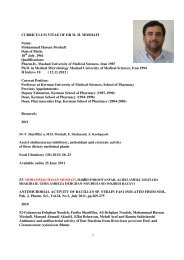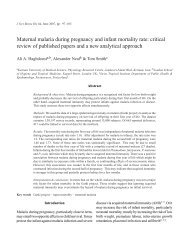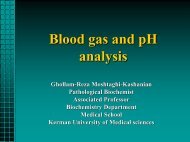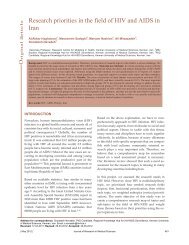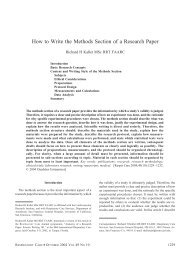Introduction to biochemistry.pdf
Introduction to biochemistry.pdf
Introduction to biochemistry.pdf
You also want an ePaper? Increase the reach of your titles
YUMPU automatically turns print PDFs into web optimized ePapers that Google loves.
<strong>Introduction</strong> <strong>to</strong> <strong>biochemistry</strong><br />
Moshtaghi-Kashanian<br />
Associated professor<br />
Kerman University of Medical Sciences
What is Biochemistry<br />
Biochemistry is mother of different field in medicine<br />
1. Ana<strong>to</strong>my<br />
2. Physiology<br />
3. Pharmacology<br />
4. Genetic<br />
5. Immunology<br />
6. Bacteriology<br />
7. Immunology<br />
8. Parasi<strong>to</strong>logy<br />
1. Internal medicine<br />
2. Surgery<br />
3. Endocrinology<br />
4. Dentistry<br />
5. Psychology<br />
6. Sociology<br />
7. Nursing
Definition of Biochemistry<br />
“Chemistry of Life”<br />
Living Things are composed of lifeless molecules<br />
Doesn’t fully take in<strong>to</strong> account what chemistry is<br />
Biochemistry- Study of the structure, properties and<br />
changes of bio-matter
Special Considerations<br />
1. Complex and highly ordered<br />
2. Everything has a function<br />
3. Living things transform their environment<br />
(extract energy)<br />
4. Self-replicating<br />
5. Reactions occur at constant temperature,<br />
pressure and pH; in an aqueous environment
Biomolecules - Elements<br />
C, H, O, N 99% of mass of most cells<br />
P, S<br />
Mg 2+ , Na + , K + , Ca 2+ , Cl -<br />
Fe, Zn, Mn, Co, Cu
Biomolecules - Macromolecules<br />
1. Carbohydrates- made up mostly of 7<br />
monosaccharides<br />
2. Proteins - 5 × 10 6 , made up of 20 amino acids<br />
3. Nucleic Acids - 1,000, made up of 4 nucleotides<br />
4. Lipids
Water<br />
• 70% of most organisms<br />
• polar<br />
• favors solubility<br />
• directionality holds macromolecules in given<br />
conformations
Water<br />
• hydrogen bond<br />
• half-life < 1/1,000,000 sec<br />
• holds water <strong>to</strong>gether without being viscous<br />
• high specific heat<br />
• colligative properties<br />
• weakly ionizable
Sizes of living things
Cell Structure
Cell Membrane<br />
• Appears as 3 layers by EM<br />
• 7.5-10 nm thick<br />
• “Unit membrane”<br />
These three things are explained on<br />
a molecular level as a<br />
phospholipid bilayer<br />
Function: osmotic barrier<br />
Present in all cells<br />
Further consideration in lipid<br />
material.
Nucleus<br />
• Bounded by a porous<br />
nuclear membrane<br />
Function: contain DNA<br />
Present in all eukaryotic<br />
cells<br />
• 1 per cell<br />
• Often 1-4 nucleoli
The nucleus and the nuclear envelope
Cell Wall & cell membrane<br />
Thick, <strong>to</strong>ugh wall<br />
Function: rigidity<br />
Present in plant and prokaryotic cells
Animal cell ana<strong>to</strong>my
Plant cell ana<strong>to</strong>my
Mi<strong>to</strong>chondria<br />
• Shape varies, size varies<br />
• 500-2,000 per cell
Mi<strong>to</strong>chondria<br />
Function: “powerhouse of the cell”<br />
Present in all eukaryotic cells<br />
Structure: compartments<br />
Further consideration in metabolism.
Endoplasmic Reticulum<br />
Rough and Smooth<br />
Phospholipid bilayer surrounding a lumen ± ribosomes<br />
Function: protein synthesis (rough) lipid synthesis (smooth)<br />
Present in all eukaryotic cells (lots)
Rough Endoplasmic Reticulum<br />
Surface looks rough because of the presence of ribosomes,<br />
another organelle (present in all cells)
Golgi Apparatus<br />
His<strong>to</strong>rically cis, medial and<br />
trans: trans-golgi network<br />
Function: protein processing<br />
and secretion<br />
Present in all eukaryotic cells<br />
(lots)
Lysosomes<br />
• About as big as a<br />
mi<strong>to</strong>chondrion<br />
• not much <strong>to</strong> see<br />
Function: degradation of<br />
proteins<br />
Present in animal cells, plant<br />
cells have similar organelle<br />
called peroxisome<br />
Number per cell varies<br />
enormously
Chloroplasts<br />
• Stacks of “grana”<br />
• grana composed of<br />
thylakoid disks<br />
Function: pho<strong>to</strong>synthesis<br />
Present in pho<strong>to</strong>synthetic<br />
cells<br />
50-200 per cell
Cy<strong>to</strong>plasm<br />
Aqueous, solute-containing contents within the plasma<br />
membrane<br />
Contains soluble proteins, salts, organelles<br />
Cy<strong>to</strong>sol- is the supernate of a centrifugation process
Microtubules<br />
• Polymer of a protein called actin<br />
• Gives shape <strong>to</strong> cell, also functions in transport<br />
around the cell
4 classes of macromolecules<br />
Carbohydrates: Energy,<br />
structure<br />
Lipids: Energy, membranes<br />
Proteins:<br />
etc.<br />
Catalysts, structure,<br />
Nucleic Acids: Information
Macromolecules: Carbohydrates<br />
Glucose isomers
Macromolecules: Carbohydrates<br />
Carbohydrates
Polymerization<br />
glucose fruc<strong>to</strong>se sucrose
Making & breaking polymers
S<strong>to</strong>rage polysaccharides<br />
starch<br />
glycogen
Cellulose: A structural polysaccharide
Chitin: a structural polysaccharide
Fatty acids &<br />
triacylglycerol
Cholesterol:<br />
a steroid
Polar & charged amino acids
Nonpolar amino acids
Macromolecules: Proteins
Structural proteins
Protein Structure: 4 Levels<br />
Primary<br />
Secondary<br />
Tertiary<br />
Quaternary
lysozyme<br />
Primary structure of protein:<br />
the amino acid sequence
Amino Acid Structure<br />
R is different for different amino acids.
Polymerization<br />
is peptide bond<br />
formation
lysozyme<br />
Primary structure of protein:<br />
the amino acid sequence<br />
Primary structure is due <strong>to</strong> strong<br />
covalent peptide bonds joining amino<br />
acids <strong>to</strong>gether.
lysozyme<br />
Secondary structure:<br />
group of amino acids<br />
folded repetitively <strong>to</strong><br />
make a discrete shape.
lysozyme<br />
Secondary structure:<br />
group of amino acids<br />
folded repetitively <strong>to</strong><br />
make a discrete shape.<br />
due <strong>to</strong> hydrogen<br />
bonds between<br />
amino acids’<br />
backbones.
lysozyme<br />
Tertiary<br />
structure:<br />
the overall 3-d<br />
conformation of<br />
a polypeptide.
Tertiary<br />
structure<br />
involves several<br />
kinds of bonds.
Tertiary Structure<br />
Most proteins are<br />
hydrophilic outside,<br />
hydrophobic inside.
Macromolecules: Nucleic Acids<br />
Deoxyribonucleic<br />
Acid
Nucleic Acids are Polymers
pH and Buffers
Water is Weakly Ionizable<br />
• 2 H 2 O OH – + H 3 O +<br />
• Weakly means this doesn’t happen often<br />
• [OH – ] = [H 3 O + ] = 1 × 10 -7 M,<br />
• [OH – ] × [H 3 O + ] = 1 × 10 -14 , the basis of the pH<br />
scale
Equilibrium Constants<br />
Mathematically Represent Degree of<br />
Dissociation<br />
Keq’ is used in <strong>biochemistry</strong> <strong>to</strong><br />
denote modified standard<br />
state.
pKa’ Values are Used <strong>to</strong> Describe<br />
Ionization of Acids<br />
• CH 3 COOH + H 2 O CH 3 COO – + H 3 O +<br />
• Keq’ =<br />
• Ka’ = 1.74 x 10 -5 =<br />
• pKa’ = 4.76
Graphical Determination of pKa’<br />
• The pKa’ is the pH at the<br />
point where buffering<br />
occurs
Buffers<br />
Buffer- a compound that does not allow the pH <strong>to</strong><br />
change even if acid or base is added <strong>to</strong> the system.<br />
Amphiprotic compounds are also good buffers.<br />
Amphiprotic compound- a compound that can act as<br />
a pro<strong>to</strong>n donor or as a pro<strong>to</strong>n accep<strong>to</strong>r.
The Henderson-Hasselbalch Equation<br />
is Used <strong>to</strong> Determine the pH of<br />
Buffered Solutions<br />
pH = pKa’ + log<br />
[A – ]<br />
[HA]<br />
or pH = pKa’ + log<br />
[salt]<br />
[acid]
When pH = pKa’, There is Equal<br />
Amounts of A – and HA<br />
• Proof on board
pH Problems<br />
What will the pH of a solution be if 0.1 mL of 6 M<br />
HCl is added <strong>to</strong> 100. mL of H 2 O<br />
What will the pH of a solution be if 0.1 mL of 6 M<br />
HCl is added <strong>to</strong> 100. mL of 1 M HEPES initially<br />
at pH 7.6<br />
What will the pH of a solution be if 0.1 mL of 6 M<br />
HCl is added <strong>to</strong> 100. mL of 50 mM HEPES<br />
initially at pH 7.6
Choosing a Buffer<br />
• pKa ± 0.5 pH units<br />
• ionic strength: use 50 or 100 mM<br />
• metal ion chelation, etc.



